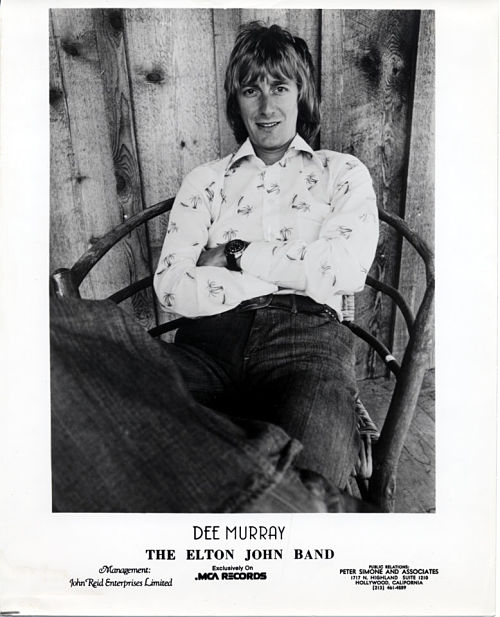Fifty Years On: Dee Murray & Rock’s Greatest Live Album 11.17.70

By Thomas Semioli
Who’ll walk me down to church when I’m sixty years of age, when the ragged dog they gave me has been ten years in the grave…
To my baby boomer generation, the live album revealed the true mettle of a rock and roll recording artist.
The mercifully truncated single concert slab or the more exotic and oft bloated twofer or threefer or monstrous four-fer*, replete with gatefold and perhaps a poster, was a treasured keepsake for those of us who experienced a band on stage.
And for those that never had the chance to witness such an event, it was a testimonial to the power of the music rendered in the moment.
Relatively easy and inexpensive to produce, record, release and generate cash for the record company and to a lesser extent, the artist – the live album remains a godsend of the rock era.
The self-indulgence, pomp and circumstance, and sheer majesty of such collections – usually enhanced with overdubs (try singing and playing in tune every night on a grueling tour) and augmented crowd noises, is to be treasured.
The extended jams, the occasional re-arrangements, muddy mixes, medleys, musical missteps, and sheer bloatedness and gargantuan excess of the platform merits endless celebration – simply because if rock and roll is indeed the art-form of “over the top-ness” so be it the live album as its enduring monument.
It is a medium that belongs to us. By the 1980s the live album was mostly archaic – reserved for jam bands and the like. In the 1990s with the (mostly) low-level musicianship of the alt-rock genre, live albums descended into historical documentation status. Mere product. By 2000, the game was over.
The list of rock artists whose concert recordings which wore out on the turntable is, in a word, astounding:
The Allman Brothers Live at the Fillmore East (1971), The Who Live at Leeds (1970), Cheap Trick At Budokan (1979), Rolling Stones Get Yer Ya-Ya’s Out (1969), Grateful Dead Europe ’72 (1972), Jimi Hendrix Band of Gypsys (1970), Deep Purple Made In Japan (1972), Peter Frampton Frampton Comes Alive (1976), Thin Lizzy Live & Dangerous (1978), Little Feat Waiting for Columbus (1979), Cream Wheels of Fire (1968), Joe Cocker Mad Dogs & Englishmen (1970), Grand Funk Live Album (1970) Grateful Dead Grateful Dead (1971), Lou Reed Rock and Roll Animal (1973), Mott The Hoople Live (1974), Leon Russell Leon Live (1975), Humble Pie Rockin’ the Fillmore (1971), The Band Rock of Ages (1972), Yes Yessongs (1973), Van Morrison It’s Too Late to Stop Now (1974), Emerson Lake & Palmer Pictures at an Exhibition (1971), King Crimson USA (1974), Bob Seger Live Bullet (1976), Rush All The World’s a Stage (1976), The Byrds Untitled (1970), Genesis Seconds Out (1977), David Bowie David Live (1974), Queen Live Killers (1979), Neil Young Rust Never Sleeps (1979), Judas Priest Unleashed in the East (1979), Motorhead No Sleep ‘Til Hammersmith (1981), Warren Zevon Stand In the Fire (1980), Santana Lotus (1974), Joni Mitchell Miles of Isles (1974), Frank Zappa and the Mothers of Invention Fillmore East (1971) and Roxy & Elsewhere (1973), Genesis Live (1973), Lou Reed Take No Prisoners (1978), 10cc Live and Let Live (1977), Velvet Underground 1969 (1974), Crosby Stills Nash & Young Four Way Street (1970) ….. and *Chicago Live at Carnegie Hall (1971) – a four album box set with horn solos! Whoa!
For my money ($3.98, Sam Goody), the best of the motley is Elton John’s 11-17-70.
Originally a WABC-FM radio broadcast from A&R Studios in New York City, the gig was never intended for a release. However, given the flood of bootlegs circulating, along with Elton’s rocketing popularity, MCA Records decided to put out an official version. The 80-minute concert was edited down to 48- minutes in a new running order. It appeared on retail record and 8-track racks April 9, 1971 as a single platter.
11-17-70 could be considered the birth of the piano power trio. Drummer Nigel Olsson, bassist Dee Murray, and Sir Elton ripped through deep cuts from John’s repertoire, which at the time included two American slabs, along with a few contemporary covers. Their improvisatory disposition merits comparison to Cream, the Allman Brothers, or a small jazz ensemble led by Miles, ‘Trane, or Bill Evans.
The live interpretations hardly resembled Elton’s orchestrated studio renditions – which, for some reason, were cut with studio cats and not this agile road band.
By this juncture in their career Elton, Nigel, and Dee were a seasoned outfit, riding the wave of the piano player’s first forays of fame and fortune. Forging a three-way musical dialogue, Nigel created a rhythmic anchor for Dee and Elton who expanded the harmonic boundaries of John’s compositions and Bernie Taupin’s cinematic libretto.
Murray worked a Fender Jazz, favoring the bridge pick-up, which cut like a knife yet retained the warmth of a traditional bass. I can’t help but think that Jaco heard these recordings and decided to try that tonal adjustment to his own liking.
On 11-17-70 Dee reveals himself to be a maestro accompanist. His deft meld of chords, arpeggios, chromatic runs, staccato phrases, sustained passages, and endless combinations thereof – to my ears, evoke comparison to Jack Bruce, James Jamerson, and Scott LaFaro.
But don’t take my word for it, listen to the album in it’s 1996 remastered, bonus track format:
“Bad Side of the Moon” https://youtu.be/ah9OS-ziAcI
“Amoreena” https://youtu.be/ddJl5QccBHc
“Take Me to the Pilot” https://youtu.be/cC1ocO0pVgs
“Sixty Years On” https://youtu.be/rRngmF-AcFQ
“Can I Put You On” https://youtu.be/ZIp-gn3xmMc
“Honky Tonk Woman” https://youtu.be/s5EbECPUO88
Medley “Burn Down the Mission, Get Back, My Baby Left Me” https://youtu.be/I370NFAPt8E
Coda: Tom Semioli / Huffington Post “11 Bass Players Who Belong in the Rock and Roll Hall of Fame”
Dee Murray https://bit.ly/2UBjiyg


